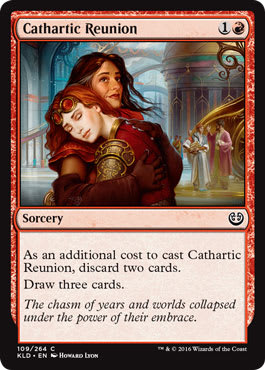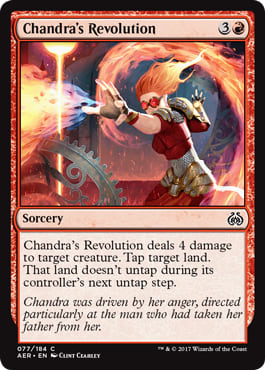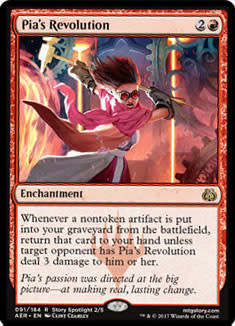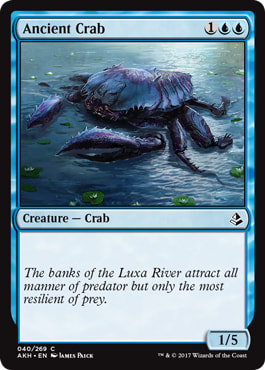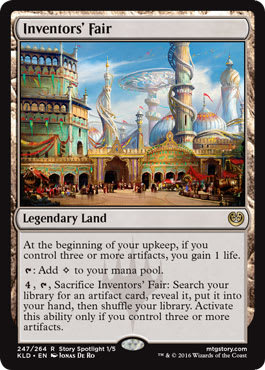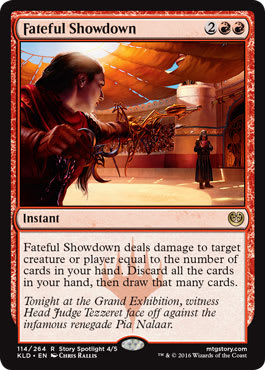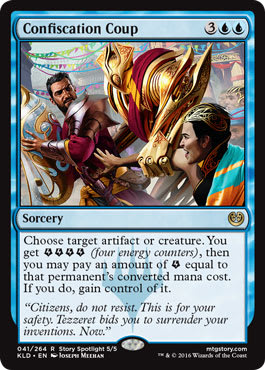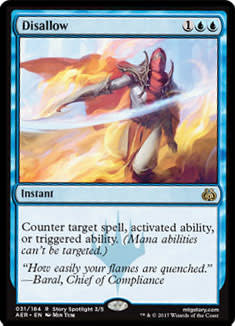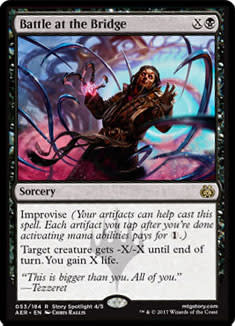For those coming into this fresh, the Story Spotlights are a new subset of cosmetically marked cards that represent "the five most crucial" moments of each set's story. The Story Spotlights have the increasingly iconic Planeswalker logo imprinted on them (though, oddly, they aren't searchable yet by watermark in Gatherer) and are numbered from 1 to 5 in order of story events.
Now, I'm not going to go into a whole history lesson in this article on the use of cards to tell Magic's story, but it's worth noting that stuff like this has been tried before. Most famously, the Weatherlight Saga, running from 1997-2001, had a tight correspondence between cards and story, with many of the major and, notably, loads of minor story events depicted on the cards. Ant Tessitore noted back in 2015 that WotC's plan to print key story moments is, in a lot of ways, a refinement of the storytelling structure of Weatherlight, as is the return to a long-term storyline . . . but these storyline cards are intended to be much more limited, due to the problem with Weatherlight where people got more than a little sick of lead character Gerrard Capashen after seeing his face all over the place. What's more, the major problem in the Weatherlight Saga of people not being able to put the hundreds of cards into a coherent narrative order is mitigated by the fact that the Story Spotlight cards are, you know, numbered explicitly in order.
This suggests that they've worked all the bugs out, right? Well, sort of. See, there's some weirdness to the Story Spotlight cards still, and I think it's worth taking a look at what cards were chosen and ask whether you really can get the basic storyline of Kaladesh in just ten cards. I know that when I was following Kaladesh's previews I was bewildered by several cards that seemed like they should be Story Spotlights but just . . . weren't. Cathartic Reunion stands out, for example, as Diabolic Tutor, Dramatic Reversal, and (most egregiously perhaps) Impeccable Timing. Pia's Revolution is a rare story spotlight card . . . Chandra's Revolution is a paltry common, and NOT a spotlight. And hey, that's another odd thing: these cards are all rares! We know from Mark Rosewater's articles that if a theme isn't at common, it's not your theme . . . so what gives?
We actually have the tools we need to dig into the choices made here, I think, though those tools come not necessarily from game design but from narratology and comics theory. Plenty of scholars over the last half century or so have written about the building blocks that make up narrative, and we can make use of that work to talk about these story spotlight cards.
The two scholars I'm personally most familiar with are Roland Barthes and Neil Cohn. These guys are at opposite ends of the timeline — Barthes working back in the middle of last century and Cohn publishing now —and each have their own focuses — Barthes mainly on novels (in his narratology anyway) and Cohn on comics — but there's some notable similarities that, without getting too bogged down in the specifics of their methods, we can use to make sense of the Story Spotlights.
See, For Barthes and Cohn, moments within a textual or visual narrative can be classified according to how essential they are. Let's quickly break down some of the basics of their systems:
Barthes breaks down narratives into indices and functions — crudely, information and action — and then functions are broken down into cardinal functions, the nuclei of stories, and the less crucial catalyzers, actions that happen but don't really reshape the overall structure of the plot. He breaks down indices further too but we're not going to get into that today. The important thing here is that there's a distinction between the core moments essential to the story's structure, and all the . . . other stuff, basically. Everything else, the stuff that doesn't reshape the narrative. Narratives, for Barthes, get their SHAPE from cardinal functions, but they get their TEXTURE from all that other stuff.
Cohn's work on comics panels has some notable similarities. He has a classification system for panels that's a bit more complex than Barthes's, and one that's centered fully on action arcs. His scheme of orienters, establishers, initials, prolongers, peaks, and releases is based around the way an action is initiated then concluded, and while I'm not going to define each of his moments you can probably intuit what a lot of them mean just from their names. The really important thing is that for Cohn, not unlike Barthes, a peak is a kind of core action unit that "marks the height of narrative tension and point of maximal event structure" whereas things like prolongers and orienters work to give the reader information about the context of the action, or elaborate on a single action with more detail.
You can think of this kind of like the difference between a set of polygons and the bumpmap that goes on top of it, if you're familiar with 3D animation at all. The underlying polygons for a rock might be pretty simple, just a few triangles stuck together. But when you stick a texture over it you can create lighting effects that make the rock seem, well, rock-like. And the same underlying polygon — the same underlying narrative beats — can look like radically different rocks if the texture is changed!
Or hey, it's kinda like the way the recently revealed Amonkheti Ancient Crab has a much different place and meaning than its Dominarian and Zendikari counterparts! Same name, same mechanics, same card, same crab . . . except with a different art, flavor text, and context "ancient" goes from "literally displaced in time" to "astonishingly old and hardy despite living in a river full of probably undead crocodiles."
So that's the theory . . . how does it work in practice? Can we actually look at the Story Spotlight cards and get from them the narrative of Kaladesh, and can we expect to get the narrative of Amonkhet from its Story Spotlights? I think the implication is that we SHOULD be able to. It's hard to imagine what else is meant by "the basic plot" right?
Well, let's take a look through the Story Spotlights that we have for Kaladesh and Aether Revolt. The core elements of the story of Kaladesh are: there's an Inventors' Fair, the notorious renegade Pia Nalaar is captured (by Tezzeret no less), Chandra and Nissa are locked in some gear-covered chamber, Tezzeret and Pia Nalaar fight, and the Consulate confiscates everyone's artifacts.
That's a pretty fair summary, but it's interesting what's left out: the conclusions to a lot of these moments. We don't see Ajani leaping in to rescue Nissa and Chandra, nor do we see the Gatewatch as a whole arrive in the middle of Tezzeret's fight with Pia. We see these on other cards but if we're treating the Story Spotlights as our cardinal functions or peak "panels," those moments don't register. That's interesting.
Meanwhile, in Aether Revolt , we see the Consulate crack down after the confiscation coup, Pia launches the titular Aether Revolt, Baral . . . does . . . something . . . with counterspells . . . and there's a battle at a bridge with Tezzeret, and the narrative leaves with a teaser for the next movie, I mean story, hinting at the machinations of Thanos, I mean Bolas.
I'm being a little willfully dumb with this — it's not hard to piece together what the "bridge" is say, for example, if you've looked at the larger set — but I'm trying to show how much core information is absent here. This part of the narrative seems even more shaky than the last one. We can't tell from these cardinal moments who actually wins the fight with Tezzeret, nor much of anything about Baral's place in the overall narrative.
I think it's pretty clear that this isn't really "the basic plot" of Kaladesh block — it's not just that there's information missing that we can get from other cards, it's that this is a deformed version of the plot, missing critical actions like Chandra not dying in a box, or Baral's defeat, or Chandra and Gideon crashing an airship into Tezzeret. Moreover, I think notably many of these cards are arguably not cardinal functions at all. If we're looking at the Inventors' Fair card as a narrative building block, I have a hard time seeing it as something other than an index, an orienter, something that tells us the context for the cardinal functions that follow.
That's ok, of course . . . though it's no wonder I was confused by what was and wasn't a worthy story moment! There's some disconnect between how these cards have been pitched and their execution, which seems much more focused on providing a skeleton of moments that might help players to orient themselves in the narrative and entice players to check out the actual story.
I think it will be worth keeping this in mind for Amonkhet. If this pattern holds, the story spotlights won't really be ALL the nuclei of the narrative — they won't be the basic shape of the story. We probably won't get story spotlights for catalyzing functions — for example, we probably won't get a story spotlight of someone in the Gatewatch getting hypothetically, I don't know, swallowed by a wurm unless that wurm really does manage to kill her, I mean them. Hypothetically. But we're not necessarily getting the major story beats. The story spotlights are more like a movie preview. A good one, I mean. Not one that gives away literally every single plot beat to the point where seeing the film seems redundant.
There's probably more to be said about what this says about the Story Spotlights as objects — if they're not so much the story as they are exciting rares used to advertise the storyline, are they as interesting to Vorthos-focused collectors as they might otherwise be? And, as parts of an overall narrative — do they provide enough of an orienting skeleton, or would it be more helpful for budding Vorthosi to have a greater number of cards given a numbered place in the story? But, these are questions that I think it'd be more useful to revisit after we're a bit deeper into Amonkhet and can see how the story spotlights are handled here.
I think these ideas about what these cards mean in terms of narrative can be a useful tool during this spoiler season, though . . . or at least I did a week ago.
If we've learned anything so far about Amonkhet, though, it's that the treacherous sands hide all sorts of strange surprises.














